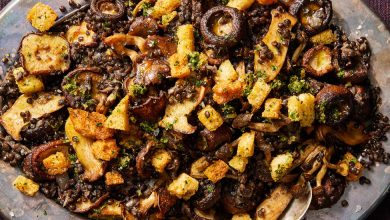Is Lodi Too Good for Rockefeller Center?

When somebody says a restaurant’s food is better than it has to be, it’s only half a compliment. Usually they mean that the food isn’t great, but it could be worse than it is and crowds would still keep coming because the place has other things going for it, like location or view.
Lodi, an Italian cafe that touched down near the end of the summer in Rockefeller Center, is so much better than it needs to be that it’s disorienting. Given its location — across from the Christmas tree, the ice rink and the window of the “Today” show set where fans used to jump up and down with hand-lettered signs for Hoda Kotb and Al Roker — it will never want for customers.
Given its competition — chain bakeries, salad-by-the-ounce counters and shops that sell boxed sandwiches — it could stay afloat with efficiency, consistency and mediocrity. Faced with a captive audience, Lodi feeds it Italian pastries, long-fermented breads and understated Northern Italian food so good that they would be worth a trip to a deserted part of town.

Lodi occupies some of the most famous real estate in Manhattan, across from the Rockefeller Center skating rink.Credit…Colin Clark for The New York Times
I have tried, and failed, to think of another restaurant in New York whose success was virtually a sure thing that went as far out of its way in pursuit of quality as Lodi goes. The nearest comparison I’ve come up with is Flora Bar, which was far and away the best museum cafe in New York during the not-quite two years of its life inside the Met Breuer (which is now the temporary home of the Frick Collection). Like Lodi, Flora Bar was run by Ignacio Mattos’s restaurant group, which also owns Estela and Altro Paradiso. Day-to-day cooking was in the hands of Maxime Pradié, now the chef de cuisine at Lodi. But while Flora Bar was far better than it needed to be, too, it wasn’t in the same class as Lodi.
To understand what Lodi does well, it helps to know what it doesn’t do at all. For one thing, it won’t seat you after 8 p.m. So if you want dinner after seeing Patti LuPone knock “The Ladies Who Lunch” into the top-row balcony seats of the Bernard B. Jacobs Theater, it will not be an option.
It also has no tables inside, although half a dozen or so are huddled within the black-canvas enclosure of the front porch and, in decent weather, even more sprawl out on Rockefeller Plaza, across from the “Today” show’s window. This is not a Covid thing. Lodi’s interior, with curves that fuse the Art Deco architecture of the plaza with the style of upper-crust Milanese aperitivo bars and fancy-food shops, was designed for traffic and turnover. Sixteen or so stools — wiry black legs, indented wooden seats, no backs — face the windows at counters around the perimeter. In the middle of the room is a narrow oval island that functions a bit like those stand-up coffee kiosks in train stations in Italy, where the typical commuter can order, pay for and drain an espresso without breaking stride.
The rest of the space is taken up by glass cases. Prime among them is the pastry cabinet, one of the most appealing and rewarding in New York, though not the most lavish. The choice is limited to about a half-dozen classics, most of them restrained and not too sugary, in the Italian style that contrasts so sharply with the all-American buttercream grenades sold down the block at Magnolia Bakery.
OK, yes, Lodi’s bombolone is basically a jelly doughnut, but it’s also kind of not — the raspberry jelly is tart and a little tannic and shares the hole in the center of the dough with whipped, barely sweet ricotta with a trace of salt.
The flauto al cioccolato is a long square tube of flaky pastry filled with dark chocolate that remains a little soft at room temperature, like Nutella; you don’t have to wait for it to melt before you can taste it. Each flauto looks like a miniature loaf of sliced Pullman bread; the illusion of slices is produced by a thin surface layer of laminated dough that has been scored into filaments about an eighth of an inch wide. It’s airy, delicate work; in a Disney cartoon, it would be done by whistling bluebirds, but it has a purpose. The technique makes the flauto’s exterior more fragile than an eggshell.
No simple breakfast that I know of, in Midtown or any other neighborhood, can beat a Lodi pastry and coffee. The espresso can be sipped, unsweetened, without puckering or grimacing. If you require something more substantial in the morning, there are steel-cut oats with honey and stewed apples, or a small pink triangle of smoked salmon with toast and a boiled egg in the shell (overcooked the day I had it).
Before last month, Lodi served breakfast and lunch, then closed in the late afternoon. Now that it stays open later, it offers a single menu of sandwiches, salads and cooked dishes for lunch and dinner. Some of these are Northern Italian recipes; all have a Northern Italian restraint.
There is a leaf of savoy cabbage loosely draped around starchy, savory rice bound with melted scamorza; lightly caramelized and then moistened with truffle vinaigrette, it may be the first stuffed cabbage I could honestly describe as graceful. Some real refinements are worked with the brasato, too, which keeps its rosy color as slow braising in red wine transforms its flavor into something both more and less intense.
The crusts have been removed from the tramezzino of saffron-scented tuna, of course, so you can elegantly nibble the sandwich while nursing an afternoon spritz flavored with clementine juice and blood-orange amaro. Chicken liver mousse, so creamy it is almost a smoothie, is piped like frosting over little oval toasts. The transparently thin chip of roasted skin slipped into the porchetta sandwich shatters on cue, and the pork itself is peppery, suffused with garlic and almost impossibly smooth for a roast.
The last three dishes would not be as fine as they are without their bread. For the porchetta sandwich and chicken liver crostini it is a long, narrow, crisp oval called the Rustica. The tramezzino is built on slices of a dense, squarish, tangy loaf called pane di riso; what feel at first like sprouted wheat berries embedded in the bread turn out to be grains of fermented rice. A basket at the start of the meal will usually hold a few slices of focaccia and of a loaf that is called, modestly, “pane.” The crumb is moist and a little sticky and has a tart, cidery flavor like Belgian lambic ale. I bought a loaf for home. It became the most interesting thing in my kitchen. Sometimes I pulled what was left of the loaf out of its bag and just stood there, admiring it.
Louis Volle is the baker responsible for the breads and pastries, too, both made with flour ground fresh each day by a stone mill in the kitchen. (You can watch it whir through a window on the plaza.) Mr. Volle previously helped manage tame and wild yeasts for Blue Hill at Stone Barns, in Pocantico Hills, N.Y.,
Arcane loaves with terrifically complex flavors are what we’ve been trained to expect at Blue Hill. They are what we’ve been trained not to expect at small, casual cafes catering to Midtown tourists and office workers. Some of these places are pretty good. Others are dismal. We may give in and buy lunch at one of them, but we know we’re just marks in the game, sized up before we walk in the door.
The only thing more dispiriting than a chain that knows how many compromises people will make for convenience is a chef trying to figure it out, and missing the mark. I’ve gone to a number of those places over the past few years. The spectacle of talented cooks’ imitating the style of chains is embarrassing.
When everything feels calculated, quality is suspect. That’s why Lodi is confusing. It isn’t a perfect restaurant, but it is gratuitously, needlessly excellent. I’m trying to get used to the concept.
What the Stars Mean Because of the pandemic, restaurants are not being given star ratings.
Follow NYT Food on Twitter and NYT Cooking on Instagram, Facebook, YouTube and Pinterest. Get regular updates from NYT Cooking, with recipe suggestions, cooking tips and shopping advice.



